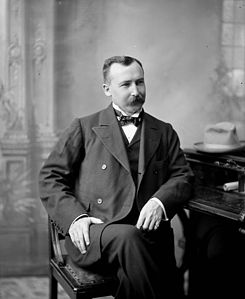Clifford Sifton
|
The Honourable Sir Clifford Sifton PC KCMG KC |
|
|---|---|
 |
|
| Minister of the Interior | |
|
In office November 17, 1896 – February 28, 1905 |
|
| Preceded by | Hugh John Macdonald |
| Succeeded by | Frank Oliver |
| Personal details | |
| Born |
March 10, 1861 Middlesex County, Canada West |
| Died | April 17, 1929 (aged 68) New York City, New York, U.S. |
| Nationality | Canadian |
The Hon. Sir Clifford Sifton, PC, KCMG, KC (March 10, 1861 – April 17, 1929), was a long-time Canadian Liberal politician best known for being Minister of the Interior under Sir Wilfrid Laurier. He was responsible for encouraging the massive amount of immigration in Canada which occurred in the first decade of the 20th century. In 1905, he broke with Laurier and resigned from cabinet on the issue of publicly funded religious education in the new provinces of Alberta and Saskatchewan.
Born in Middlesex County, Canada West (now Ontario), Sifton's father, John Wright Sifton, was a contractor and businessman who moved with his family to Manitoba when Clifford was a boy. He trained as a lawyer and graduated from Victoria University in the University of Toronto, where he was the founding manager of Acta Victoriana.
Sifton worked on his father's political campaigns before being himself elected to the legislative assembly of Manitoba in 1888. Sifton served in the cabinet of Thomas Greenway from 1891 to 1896 as attorney general and Provincial Lands Commissioner. He played a role in negotiating the Laurier-Greenway Compromise, which temporarily resolved the Manitoba Schools Question.
In 1896, Sifton was elected a Member of Parliament and served as Minister of the Interior under Laurier. As Minister of the Interior he started a vigorous immigration policy to encourage people to settle and populate the West. Sifton established colonial offices in Europe and the United States. He enticed people to come to western Canada. While many of the immigrants came from Britain and the United States, there was also, to Canada, a large influx of Ukrainians, Scandinavians, Doukhobors, and other groups from the Austro-Hungarian Empire. He famously defended the "stalwart peasants in sheep-skin coats" who were turning some of the most difficult parts of the western plains into productive farms.
...
Wikipedia
